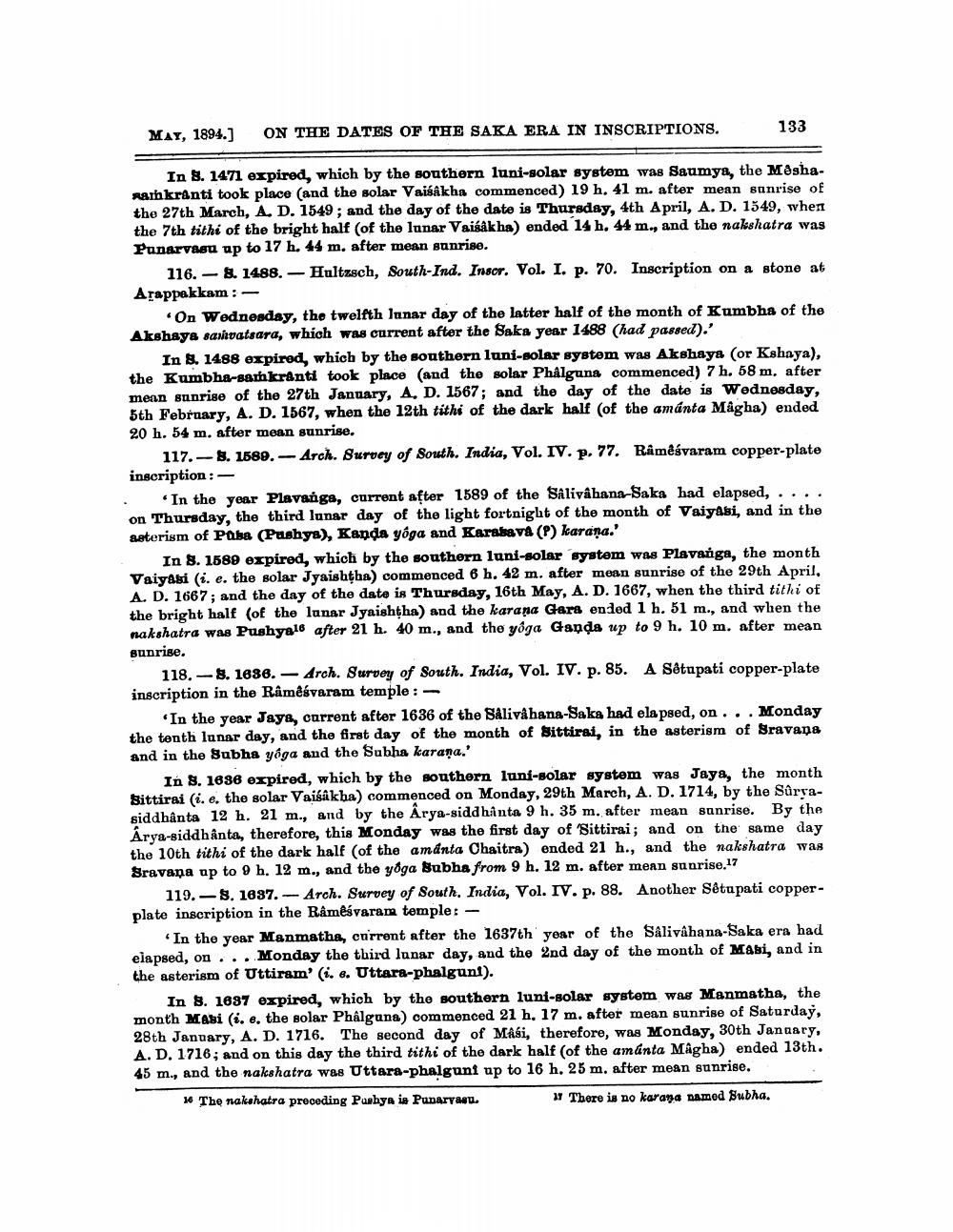________________
MAY, 1894.]
ON THE DATES OF THE SAKA ERA IN INSCRIPTIONS.
133
In S. 1471 expired, which by the southern luni-solar system was Saumya, the MeshaRamkranti took place (and the solar Vaisakha commenced) 19 h. 41 m. after mean sunrise of the 27th March, A. D. 1549; and the day of the date is Thursday, 4th April, A.D. 1549, when the 7th tithi of the bright half (of the lunar Vaisakha) ended 14 h. 44 m., and the nakshatra was Punarvasu ap to 17 h. 44 m. after mean sunrise.
116. - 8. 1488. - Hultzsch, South-Ind. Insor. Vol. I. p. 70. Inscription on a stone at Arappakkam :
On Wednesday, the twelfth lunar day of the latter half of the month of Kumbha of the Akshaya samvatsara, which was current after the Saks year 1488 (had passed).'
In 8. 1488 expired, which by the southern luni-solar system was Akshaya (or Kshaya), the Kumbha-sankranti took place and the solar Phålguna commenced) 7 h. 58 m, after menn sunrise of the 27th January, A, D. 1567; and the day of the date is Wednesday, 5th Febrnary, A. D. 1567, when the 12th tithi of the dark half of the amánta Magha) ended 20 h. 54 m. after mean sunrise.
117.-8. 1589.- Arch. Survey of South India, Vol. IV. p. 77. Râmêśvaram copper-plate inscription :. In the year Plavangs, current after 1589 of the Salivahana-Saka had elapsed, .... on Thursday, the third lunar day of the light fortnight of the month of Vaiyasi, and in the materism of Paba (Pashys), Kanda yoga and Karakava () karana.'
In 8. 1589 expired, which by the southern luni-solar system was Plavarga, the month Vaiyasi (i. e. the solar Jyaishtha) commenced 6 h. 42 m. after mean sunrise of the 29th April, A. D. 1667; and the day of the date is Thursday, 16th May, A. D. 1667, when the third tithi of the bright half of the lanar Jyaishtha) and the karana Gara ended 1 h. 51 m., and when the nakshatra was Pushya16 after 21 h. 40 m., and the yoga Ganda up to 9 h. 10 m. after mean sunrise.
118.-8. 1688. - Arch. Survey of South India, Vol. IV. p. 85. A Sötupati copper-plate inscription in the Râmêsvaram temple :
In the year Jaya, current after 1636 of the Salivahana-Saks had elapsed, on ... Monday the tenth lunar day, and the first day of the month of Sittirai, in the asterism of Sravana and in the Subha yoga and the Subha karana.'
In 8. 1836 expired, which by the southern luni-solar system was Jaya, the month Bittirai (i. e, the solar Vaisakha) commenced on Monday, 29th March, A. D. 1714, by the Sûryasiddhanta 12 h. 21 m., and by the Arya-siddhanta 9 h. 35 m. after mean sunrise. By the Arya-siddhanta, therefore, this Monday was the first day of 'Sittirai; and on the same day the 10th tithi of the dark half of the amanta Chaitra) ended 21 h., and the nakshatra was Sravana ap to 9 h. 12 m., and the yoga Bubha from 9 h. 12 m. after mean sunrise.17
119.- S. 1637. - Arch. Survey of South, India, Vol. IV. p. 88. Another Setupati copperplate inscription in the Râmêávaram temple: -
In the year Manmatha, current after the 1637th year of the Salivahana-Saka era had elapsed, on ... Monday the third lunar day, and the 2nd day of the month of Magi, and in the asterism of Uttiram' i. 8. Uttara-phalgunt).
In 8. 1637 expired, which by the southern luni-solar system was Manmatha, the month Mabi (i. e. the solar Phålguna) commenced 21 h. 17 m. after mean sunrise of Saturday, 28th January, A. D. 1716. The second day of Maši, therefore, was Monday, 30th Jangary, A. D. 1716; and on this day the third tithi of the dark half of the amanta Mâgha) ended 13th. 45 m., and the nakshatra was Uttara-phalgunt up to 16 h. 25 m. after mean sunrise.
16 Tho nakshatra preceding Pushya ia Pudarya.
1 There is no karana named Subha.




